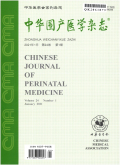摘要随着国内胎儿医学的飞速发展,宫内输血作为一项疗效确定的技术也越来越受到重视.宫内输血的原因除了常见的红细胞同种免疫,还包括微小病毒B19感染、母胎输血综合征、贫血多血质序列综合征、胎盘绒毛膜血管瘤和胎儿骶尾部畸胎瘤等.输血的主要推荐途径包括脐静脉和腹腔内输血.根据不同孕周、不同胎盘位置以及是否合并胎儿水肿,可以选择不同的输血途径,但不推荐脐动脉和心脏内作为穿刺部位.为了降低宫内输血的并发症,建议常规应用胎儿镇痛、避免穿刺脐动脉,以及更积极地采用肝内脐静脉作为输血的途径.对于第1和2次宫内输血,大脑中动脉收缩期血流峰值是良好的评价指标,首次输血以>1.5中位数倍数、第2次输血以> 1.69中位数倍数作为宫内输血的指征,而第3次及以上输血建议用胎儿血红蛋白下降速度来预测输血的时机.
更多相关知识
abstractsWith the fast development of fetal medicine in China,intrauterine transfusion,which is regarded as an effective treatment in certain conditions,has attracted more and more attention.In addition to the common seen red blood cell alloimmunization,the indications of intrauterine transfusion include parvovirus B 19 infection,maternal-fetal blood transfusion syndrome,twin anemia-polycythemia sequence,placental chorionic hemangiomas and fetal sacrococcygeal teratomas.The recommended approach for intrauterine transfusion is umbilical vein or intraperitoneal transfusion depending on the gestational age,placental location,and presence of absence of fetal edema.However,umbilical artery and intracardiac transfusion are not recommended.In order to reduce the complications of intrauterine transfusion,routine fetal analgesia,avoidance of umbilical artery puncture and prior use ofintrahepatic umbilical vein transfusion are recommended.Fetal middle cerebral arterypeak systolic velocity (MCA-PSV) >1.5 multiple of median (MOM) and 1.69 MOM can be a good indicators for the first and second intrauterine transfusions,respectively.For the third and subsequent transfusions,the rate of fetal hemoglobin decline is recommended to predict the timing of transfusion.
More相关知识
- 浏览344
- 被引5
- 下载697


相似文献
- 中文期刊
- 外文期刊
- 学位论文
- 会议论文



 换一批
换一批 换一批
换一批



